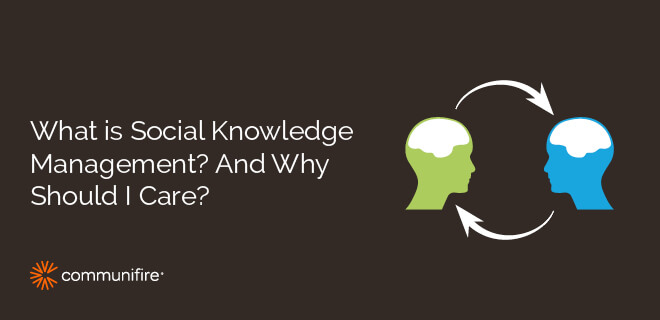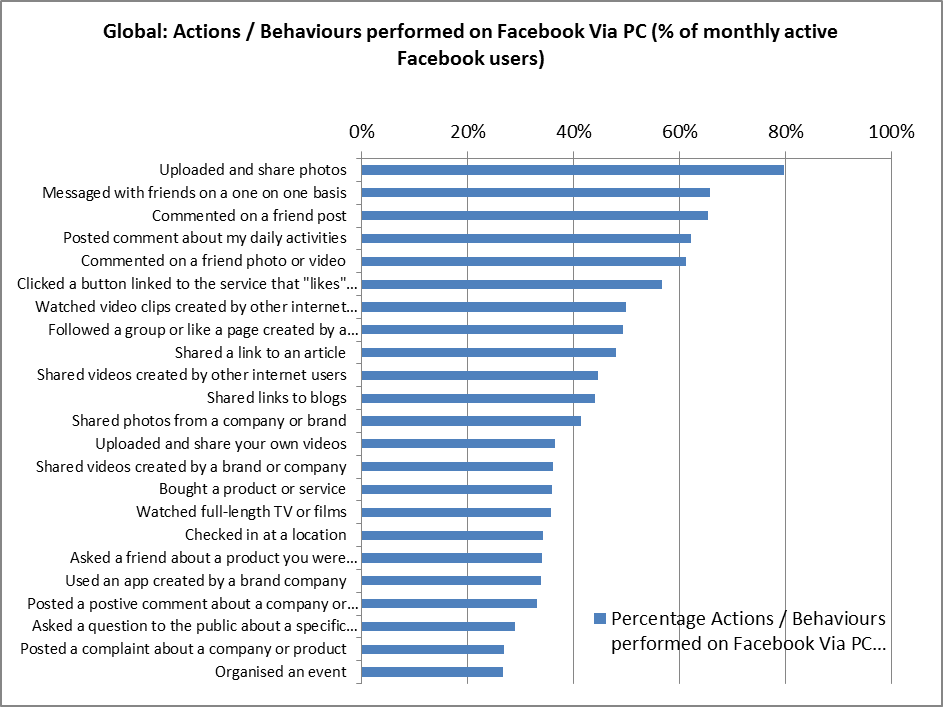You may have heard the term ‘social knowledge management’ and wondered what it is, why it matters, and how it relates to the work you’re already doing.
Or maybe not.
If you haven’t, you probably will.
With this post I’m going dive in and give you a 10,000 ft view, so you can get up to speed with this rapidly changing and evolving concept of working and managing knowledge within and outside of your organization.
I’ll first start by covering the “social media” or the public social networking landscape and how it relates … and then I’ll transition how the same concepts apply to your internal employes and organization.
Let’s start by taking a closer look at the trends in knowledge sharing in recent years.
Social sharing trends in the age of Twitter and Facebook.
?In the last decade, social media has exploded, enabling customers to engage directly with companies as well as their employees, partners, thought leaders and owners.
Consumers openly share their opinions on products, services, brands, companies, and customer service through blogs, Facebook, Twitter, Yelp, and the other 1000’s of social media websites.
Today, Customers are more engaged in the buying process prior to purchase.
In fact, before buying anything, most customers seek out online reviews of products or comparison shop on their mobile devices while they’re in-store. You’ve probably seen the QR codes next to products in BestBuy and many other stores, encouraging people to “check out more info” online … which conveniently sends them to a page with:
- more info, and
- customer reviews.
Sharing information online socially has become a powerful tool for consumers to voice their opinions … and for companies to interact, engage, and influence consumers.
This shift, highly due to social media, in both communication style and the sharing of knowledge from a hierarchial approach (which we’ll call traditional knowledge management) to peer-based knowledge sharing (social knowledge management) has dramatic effects on how people perceive companies and brands, what they buy, and who they decide to buy from. ??
This brings us to the question …
What is traditional knowledge management as compared to social knowledge management?
Let’s take a look …
Traditional knowledge management vs social knowledge management.
Traditional knowledge management involves sharing information based on existing knowledge (or documentation) and what a company decides that its employees need to know based on relevance.
It is a rigid method and is typically based on hierarchy, where employees higher-up on the company ladder receive more information than those at the entry level. Knowledge spreads through the organization only through a predetermined set of rules and channels.
Social knowledge management, on the other hand, involves the use of social business concepts … and the knowledge that employees think is important, want to share, want to consume, and allows the recipient to choose for him or herself whether or not it’s relevant or valuable to the company or to customers.
Anthony J. Bradley, group vice president, Gartner Research, and Mark P. McDonald, group vice president, and Gartner Fellow, Gartner Executive Programs, take this definition even further:
“Knowledge management is what company management tells me I need to know, based on what they think is important. ?Social media is how my peers show me what they think is important, based on their experience and in a way that I can judge for myself.”?
In the article, Social Media versus Knowledge Management, at the Harvard Business Review, they point out that knowledge must flow freely in an organization to get the best value from people collectively with “good ideas floating to the top” and growing the organization for the long term.
Social knowledge management promotes “engagement” instead of control??. And this scares a lot of the higher-ups.
In the past, knowledge in companies has always been siphoned off a “need to know” basis only.
Social knowledge, however, involves the sharing of information across the organization.
Why do companies (specifically the higher-ups) fear such a change?
Here are a few reasons:
1. There’s a perceived loss of control?.
Traditional knowledge management has a defined knowledge process of distribution, again, based on hierarchy. Companies fear that if employees and customers create and decide what information is relevant and important, they will lose control over their brand and organizational structure.
2. There’s a fear of diluting the brand?.
Another big fear among many vendor organizations is that having employees, customers, and suppliers (and anyone else closely related to the business) freely conversing and talking with each other could lead to them forming opinions without the input of the vendors management. Now that wouldn’t be good, woud it?
3. It’s chaotic, with a lack of clear structure.
Compared to traditional knowledge management tools, social media can seem chaotic, and it is, since it does not have knowledge managers or the predefined structure many organizations are used to. It does not limit the flow of information or have the same processes in place to directly control or predict it either. This can appear way too messy for organizations to learn to include.
Your people and what they know are your assets.
These fears do not take into account the changes in the workplace, communication methods, and most importantly, your people – the people who make up your workforce, your customers, your partners, your suppliers, and your fans.
People talk about your company, your brand, your products, and your services whether you want them to or not.
They will discuss your organization anywhere they want, when they want, and with whom they choose. And they have been doing this long before social media caught on as a popular method of communication.
Today, as consumers and employees share their opinions more and more openly in an increasingly transparent world, it is important to engage people.
You need to “engage” with people to build knowledge.
Here are a few reasons why:
1. You gain value from their feedback.
When you engage with people, whether they are employees, customers, suppliers, partners or clients, you gain value from the knowledge that is being shared.
And when I say engage, I mean listening, and being open to criticism, expecting it, and asking open ended questions … allowing whoever you’re conversing with the opportunity to express their emotional desires, gripes, wants, needs, and expectations.
Smart and forward thinking business leaders recognize the value in this engagement. Because you learn what people think about your company, your products, and services, and from this knowldege you can drive your decision making in the direction of building greater ties with your community.
2. Mass collaboration?.
According to our friend Wikipedia, we find the definition for mass collaboration:
Mass collaboration is a form of collective action that occurs when large numbers of people work independently on a single project, often modular in its nature.
Social business software and social knowledge sharing opens the way to mass collaboration. Mass collaboration typically utilizes some form of social media technology, putting emphasis on forming communities to collectively build knowledge and create solutions.
In his article, The Dawning Age of Mass Collaboration, Anthony J. Bradley from Gartner states:
The business potential of mass collaboration is enormous. It can turn your customers into an extension of your sales force. It can bring all of your engineers together on your biggest design challenges. It can rally your managers to formulate and drive critical change. The possibilities are endless.
Mass collaboration drives creativity and solutions. And the businesses of tomorrow will be creative companies. And within these companies, it will be the creative people that drive growth, create new products, services, and solutions … and these people will be (if they are not already) the most valuable employees.
3. Strengthening bonds with employees and customers.
Today, employees have increasingly digital lifestyles, sharing their opinions and daily interactions online. The millennials share information online and engage with social media daily.
You can reach this population and strengthen bonds by opening things up and including them in the social knowledge sharing. These people are extremely social, they share photo, status updates, videos, etc., you name it. But, they also interact with content that is shared too. They read much more than you’d expect, because they are hungry to learn. Interacting with and engaging them in a more human and social way will help you to strengthen bonds.
4. Tap into the power of engaged fans.
According to eMarketer’s January 2014 study, 80% of millennial social media users have shared photos and thoughts when trying a new product or service. They share this information on social media platforms that are growing at explosive rates, such as Flickr (247% growth rate) and Vine (643%).
The average size of a millennial’s social network is 800 people.
The average cost to acquire a millennial fan on video sites is roughly $20.
By having just one engaged fan, you can reach almost the same number of fans you would by paying for a video advertisment with just a single share of content to their existing network, almost for free (minus the cost of creating the content, which doesnt have to be all that expensive. Shoot a quick video on your iphone.).
By engaging your millennial employees and customers, you can greatly amplify your reach and brand engagement.?
Image via Global Web Index
5. Increasing enterprise level search and employee empowerment?.
Sharing knowledge socially empowers employees at all levels within your organization.
Your employees can find information they are looking for and they can use this information in their work every day. And what’s really cool, is that they can search for it on their own. If they can’t find something, they can immediately reach out to individuals, groups, or even the entire company to get help in finding it.
How to use social knowledge management instead of traditional knowledge management??.
Perhaps your organization recognizes the value of social knowledge and sharing but are unsure how to proceed.
You decide just to add social media or social business to your current processes but you are not seeing the results you want. This happens often because the organization (you) seeks to control social knowledge sharing with the same traditional knowledge management techniques they used before.
If your capabilities for knowledge management are too rigid and limiting, adding social media to the mix will not improve sharing or communication or result in greater employee productivity and organizational strength. All you will be doing is adding new, different technology, and perhaps extra work for your company as a whole.
In the ‘90s, Lotus Notes offered the vehicle for business collaboration, helping companies unlock insight from employees in a shared environment. IBM bought Lotus and Microsoft soon hired the inventor of Lotus Notes, hoping to instill the same power of Lotus Notes collaboration into their email program.
Guess where that went?
Knowledge management strategies consisted of intranets and databases to share information. However, for most companies, these old attempts at sharing knowledge have failed, as these tools do not make sharing knowledge easy, and they reflect the same hierarchy elsewhere in the organization.
Knowledge management declines when solutions are not accessible or poorly designed.
Employees cannot find the information they are looking for. Big problem #1.
So many companies have adopted solutions such as Jive, Sharepoint and others that look promising but are difficult to navigate or understand or do not offer the ease and transparency necessary for active social engagement among employees.
There’s just way too much overhead with these huge applications.
To get the real value in employee engagement and the resulting increase in productivity, these tools must be easy to use, recognize the value in social business, and encourage the flow of information freely through the organization.
Become a social organization?.
To get genuine value out of social knowledge and sharing, you will need to become a social organization. And this isn’t as difficult as it may seem. The first step is to define your purpose and then measure everything based off of that purpose. Then, adding social media to your suite of technology tools is actually growing your arsenal for powerful customer engagement. You can amplify your outreach to customers as well as boost engagement and increase productivity within your organization and with partners and clients.??
Creating a compelling purpose.
Why do people participate and share their ideas, knowledge and experience?
Purpose.
People engage with social media because they identify with the channel … because it provides them with purpose.
Social knowledge sharing allows communities to naturally rise based on interest, shared purpose, and participation using social sharing tools. Knowledge management software offers a visible, accessible platform for this engagement. Tools are easy to use and often employees are used to social sharing tools because it mirrors tools they are already familiar with in social media where they are already active. The openness of a social knowlege management platform invites sharing and participation from people within the organization quickly and easily. It also fosters the growth of active, innovative and engaged communities.
Bringing the troops with you.
Active engagement and knowledge sharing requires bringing in people with you who understand the value in having a social business, can articulate your company vision for growth with this in mind, and can turn listeners into engaged employees.
These people become cheerleaders in your organization and help push past inertia … and help ignite passion in your employees and spur engagement among employees.
Who are these people in your organization?














 info@axerosolutions.com
info@axerosolutions.com 1-855-AXERO-55
1-855-AXERO-55


